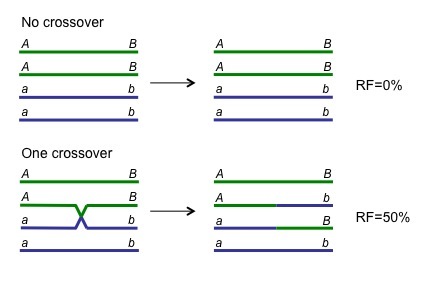Branches and Loops
Chapters 7, 8 and 11 of Hello World are the conceptual
heart of programming. (We will skip Chapter 6 and 10, as they are
about writing games. Chapter 9 on comments is important but very
easy.)
Branching
Chapter 7 of Hello World brings us
to if statements.
Gene mapping
In case a genome has not been sequenced, the distance between two
genes can still be estimated based on the frequency of crossovers that
occur during meiosis. The image below shows that a crossover results
in a recombination frequency of 50%.

The map distance (d) can be estimated based on the recombination
frequency (RF) using the Haldane’s mapping equation:
d=-1/2 * ln(1-2*RF)
The recombination frequency is never negative, nor higher than 0.5.
Write a program that asks for a recombination frequency as input and gives the map distance as output.
In case a frequency lower than zero or higher than 0.5 is entered, the program should tell the user
that the recombination frequency must be between 0 en 0.5. The natural logarithm can be calculated using log() from
the numpy library.
For loops
Chapter 8 of Hello World introduces simple loops.
The range() function is very important.
Population Dynamics
The number of predators and prey in a region depend on each other.
Let's make the following assumptions for a model describing these relationships:
The prey population increases by
5% each day as the net result of birth and natural death. At the same time,
the population is decreased by the presence of predators. The more
predators there are, the more prey is being caught and the more prey there
is, the easier it is for predators to catch the prey. Specifically,
the prey population is reduced by 0.0002*number of predators*number of
prey, which are present at the start of the day.
The predator population decreases by 10% per day. In addition, the
presence of prey has a positive
influence on the number of predators. This depends on how much prey is
being caught and this is again dependent on the number of predators as
well as the number of prey. The increase amounts to
0.0001*number of predators*number of prey each day. The numbers are again
those at the start of the day.
You may wish to try some warmup
problems before the following.
Evaluate how much predator and prey there will be after 200 days if there
are 1000 prey and 100 predators present in the beginning. You don’t need to
round the numbers.
If you evaluate different numbers of days, you will find that the populations
fluctuate over time. In this example, the predator and prey populations
change according to the Lotka-Volterra equation, except for that that equation
describes the changes per infinitely small time step, instead of per day. The
equation is further discussed in the dynamical systems part.
General loops
From Chapter 11 of Hello World, covers general loops.
You may also find this video lecture
on general loops useful.
Now we have if branches and while loops at our
disposal, and we can put loops within branches within loops, to as
many levels as we want. With this ability, plus the resources to read
and write files as much as we want, we have a minimal but complete
programming language, said to be Turing complete, or equivalent to a
a Turing machine.
You may try
more warmup problems
before continuing below.
Turing and ESP
There is no getting away from Alan Turing in abstract discussions
about computers. In 1950, Turing wrote a philosophical article
on
Computing Machinery and Intelligence. In it, Turing proposes what
he calls an `imitation game' (now called the Turing test). A human
`interrogator' is talking by teletype to two `witnesses', one human
and one a computer. The interrogator's job is to figure out which is
which. The human witness's job is to help the interrogator, the
computer's job is to confuse the interrogator (that is, pretend to be
the human). Turing proposes the ability, if achieved, to fool most
human interrogators as an operational definition of intelligence.
The whole article is entertaining. Most of it consists of Turing
considering and wittily rebutting nine different objections to his
proposal. The last of these is that humans are allegedly capable of
extra-sensory perception, but computers are not. Turing's discussion
includes the following passage.
Let us play the imitation game, using as witnesses a man who is good
as a telepathic receiver, and a digital computer. The interrogator can
ask such questions as `What suit does the card in my right hand belong
to?' The man by telepathy or clairvoyance gives the right answer 130
times out of 400 cards. The machine can only guess at random, and
perhaps get 104 right, so the interrogator makes the right
identification.
Getting the card suit right 130 times in 400 trials does not sound
so impressive. How often would random guessing do at least that
well?
Generate the following console output:
Random guessing yields at least 130 correct suits out of 400 trials in ...% of the cases.
If you wish, you can browse ahead at this point to Chapter 23
of Hello World, which is on random numbers. But it is not
essential, as the simple function we saw in the number-guessing
example in the first chapter is also adequate.
Submit the program
Text Files
File input/output is covered in detail in Chapter 22 of Hello
World, but the essentials are in this short example containing a
while-loop
inp = open('original.txt')
out = open('copy.txt','w')
while True:
s = inp.readline()
if not s:
break
out.write(s)
inp.close()
out.close()
Files like .txt and .csv can directly be
opened in this way. For more specialized file formats special
functions are required to read and write them. Many such functions
are available in different libraries. The urllib.urlopen
function from Chapter 5 is just one example.
Write a program that can read a FASTA text file and
output just the lines containing the sequence.
